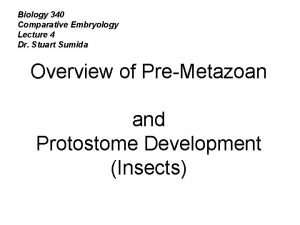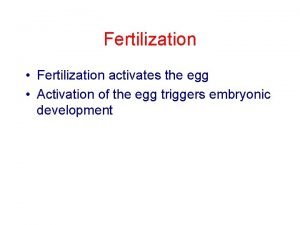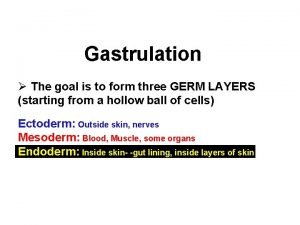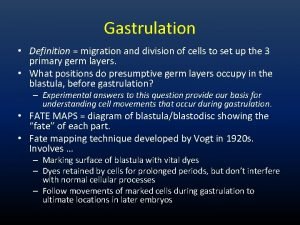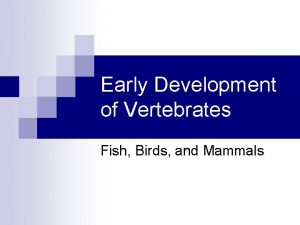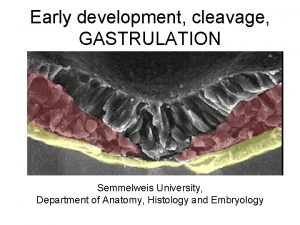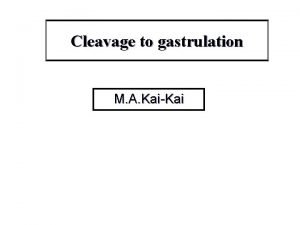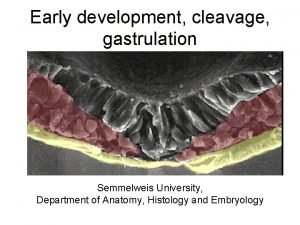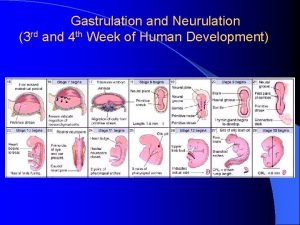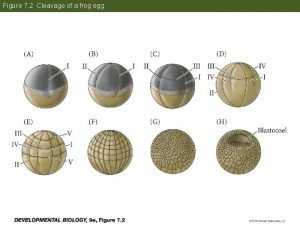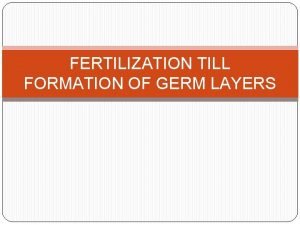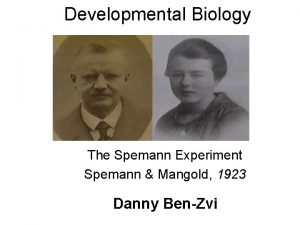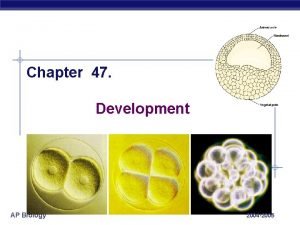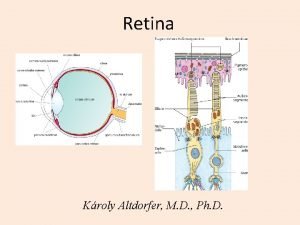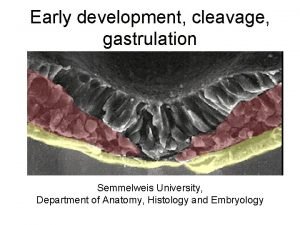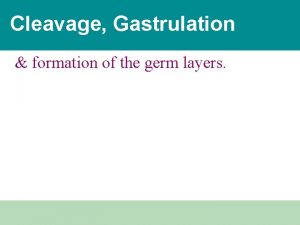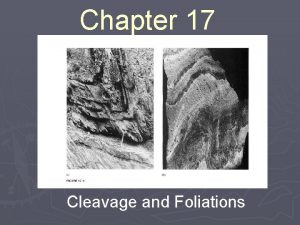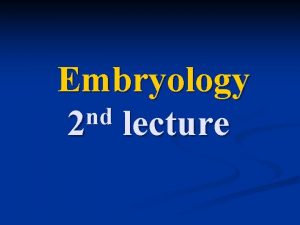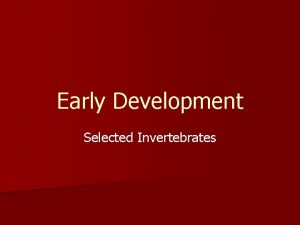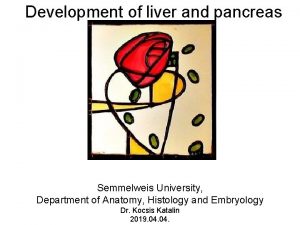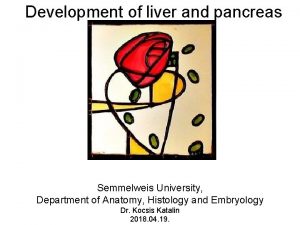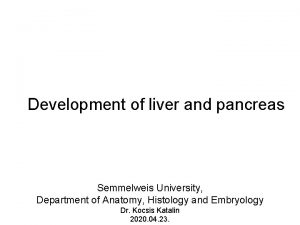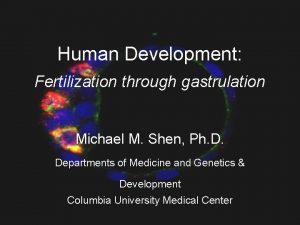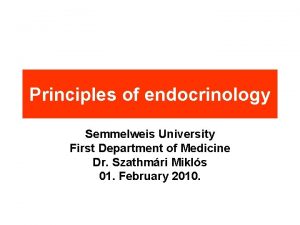Early development cleavage gastrulation Semmelweis University Department of






























- Slides: 30

Early development, cleavage, gastrulation Semmelweis University, Department of Anatomy, Histology and Embryology

The zygote =fertilized egg The new diploid cell is created by the fusion of the male and female pronucleus ( )

Cleavage • Mitotic division process • Cleavage stage cells: blastomeres • The volume of egg’s cytoplasm divides into numerous smaller, nucleated cells → in humans whole cytoplasmatic volume of the egg packs into smaller and smaller blastomeres • The human cleavage is equal, but asynchronous

Different type of cleavage • The cleavage process is influenced by the yolk contents of the egg. Incomplete (Meroblasticus) fish, reptiles, birds • The egg may contain large or small amount of yolk • The distribution of the yolk: • uniformly • concentrate on one of the pole of the egg. Complete • Due to the asymmetric yolk (Holoblasticus) distribution: • Only a part of the egg pack into blastomeres • blastomeres have different size • Complete and incomplete types of cleavage can be distinguished Frog Human



What stage is DNA in embryo first transcribed? Little increase in RNA during the first 2 -8 days. In the mouse as early as 2 cell by blastocyst stage produces adult levels. Protein synthesis occurs at 2 -4 cell where there is a large increase. In most species, the rate of cell division and the placement of the blastomeres are completely under the control of the proteins and m. RNAs that are stored in the oocyte cytoplasma. So they come from only the mother. The zygotic genome does not function in earlycleavage embryos until 2 -4 cells stage in human. Because the sperm and egg contains highly compressed and methylated DNA which are not capable to be transcripted. After the 4 cell stage, the embryonic DNA gradually demethylated and transcription of proteins starts from it. Evidence indicates that maternal and embryonic m. RNA are used during early cleavage, with loss of maternal RNA by blastocyst stage. If you block RNA synthesis with actinomycin D (reduces RNA synthesis by 90 and depress cleavage, only reduces protein synthesis by 50%. Evidence ind that the embryonic genome does not begin to control the course of developm until blastulation.

Compaction -in the 8 -cell-stage cleavage. -The blastomeres, which show loose arrangement, suddenly form a compact ball -Before the compaction blastomeres loosly adhere to each other by microvilli on their surface. -After compaction blastomeres tightly adhere with each other through intercellular junctions before compaction and after compaction

• Compaction is a membrane polarization process → well-defined apical, basal and lateral side is developing. • Different components of the cell membrane concentrate at different regions of the cell causing the polarization of the cells. • Membrane polarization is influenced by cell -cell interactions • This polarization process takes place only in those parts of the cell membrane where the cell is in contact with other blastomeres. • E-cadherin plays a main role in compaction. • At 2 -cell stage, E-cadherin is uniformly spread throughout the cell membrane. During compaction E-cadherin becomes restricted to those sites of cell membrane where adjacent blastomeres are in contact with each other. • E-candherin molecules accumulate and form zonula adherens

16 -64 cells stage

Blastula formation • Newly formed structures between the outer blastomeres: -tight junctions (apical part) -gap juction (lateral part) -membrane transport molecules on basal part: mainly sodium pumps • Due to the activated sodium pumps the sodium concentration increase in the intercellular space and parallel the water flows into the intercelullar space by osmosis → forming fluid filled cavity called blastocoel. • The blastocoel is expanded gradually by the increasing amount of the fluid

The expanding blastocoel push the internal cells on the one side of the blastocyst → inner cell mass (ICM) In mice: • trophoblast cells differentiate into the fetal membrane system • inner cell mass forms the whole body of the embryo and extraembryonic edoderm

Twins • Monozygotic twins arise from one zygote • Dizygote twins arise two different eggs, that are fertilised by two different sperms . Monozygotic twins • At cleavage: after the first cell division the newly formed two blastomeres completely separete from each other. • At blastulaion: the subdivision of the inner cell mass within the blastocyst.

The differentiation of the ICM cells into a bilaminar structure containing epiblast and hypoblast layer. The sorting model At the beginning, the epiblast and hypoblast cells distribute within the ICM showing „salt and pepper pattern”. The sorting event, in which the bilaminar disc will be developed, is caused by two main ways. 1. : the different strenghts of adhesion between the two cells type (adhesion is stronger between same type cells than different type cells) and 2. : signals coming from either the blastocoel or from trophoblast (the epiblast cells express nanog while hypoblast cells express GATA 6 and this expression pattern is caused by the different FGF signaling.

Why is gastrulation so important? §Generation of the basic body plan. §Specification of the axes: §Anterior and posterior §Dorsal and ventral §Left and right §Generation of the three germ layers §Ectoderm, mesoderm, and endoderm

Primitive streak, groove Anterior • Gastrulation begins with the formation of primitive streak. Epiblast ploriferate and they are pushed toward the midline of the embryo → they are jammed in the midline forming the primitív streak that first appear in the posterior part of the embryo. • Cells , which are located in the middle of the primitív streak, migrate into the interior of the embryo resulting the formation of primitív groove in the middle of the primitív streak. Posterior

Hensen’s node • The primitív streak with the primitív groove is growing gradually anteriorly • At the anterior end of the primitív streak there is a small but well-defined accumulation of cells, called primitív node or Hensen’s node. cranial side caudal side Cranio-caudal, left-right axes well-defined!

What ‘s happen with the cells in the primitive groove? • The movements of the cells are accopamanied by major changes in their structure. • When epiblast cells enter the primitív streak, they become elongated and lose their connection with their adjacent cells → their morphologes change forming bottle cells. • Within the primitív groove these bottle cells lose their connection with the basal lamina become free from the epiblast layer. • Bottle cells undergo an epithelio-mesenchymel transformation within the primitív groove and the newly form mesenchymel cells are able to migrate as individual cells. • During the epithelio-mesenchymal transformation the E-cadherin synthesis downregulate within the bottle cells, Epithelial cell E-cadherin epiblast „slug” FGF 8 Ecadherin mesoderm endoderm





D 1415 Development of the definitive endoderm Bi-laminar embryonic disk Hypoblast cells develop only into extraembryonal mesoderm Primitive streak Epiblast Hypobla st First entering epiblast-cells migrate and replace the hypoblast-cells forming the definitive endoderm Endoder m Epiblast cells give rise to the three germ layers of the embryo!!

Development of the Intraembryonal Mesoderm Primitive streak D 16 epitheliomesenchymal transformation Intraembryonal mesoderm Epiblast-cells migrate in the interlaminar space and forming intraembryonal mesoderm Definitive entoderm

Migration of the Mesodermal Cells • The newly form mesenchymal cells migrate and spread bilaterally. Epiblast Mesoder m Entoderm • Those cells, which pass through at the level of Hensen’s node, migrate directly cranially and form the precordal plate and later take part in the formation of the notochord. Epiblast Entoder m

Primitiv streak regression • At the beginning of gastrulation the primitiv streak grows cranially • The primitiv streak growing changes for its regression. → its length is decreasing toward caudally • This regression process is related with the elongatoin of the notochord • The notochord is formed by the addition of cells to its caudal end while the primitiv streak become shorter and shorter

1. : At the biginnig of the notochord process first form a notochord canal with a central lumen Human notochord 3. : The notochord plate starts to infold later form the rope like notochord 2. : The floor of the notochordal canal disappears remaining a flatten plate (notochordal plate) which incorporate into the definitiv endoderm

Differentation of the mesoderm, convergent extension membrana buccopharyngea paraxial mesoderm (somites) intermediate mesoderm (nephrotom) lateral mesoderm (somatopleura, splanchnopleura) extraembryonal mesoderm primitivenode strike

Fate map GE: gut endoderm PP: prechordal plate PS: primitive streak CM: cardiac mesoderm PEEM: extraembryonic mesoderm HM: head mesoderm S: somitic mesoderm IM: intermedier mesoderm LPM: lateral plate mesoderm SE: surface ectoderm NP: neural plate PE: placod ectoderm NC: neural crest

Gastrulation wall of amnion bi-laminar epiblast three-laminar embryonic ectoderm definitive ectoderm skin, nervous system, sensory organs roof of blastocyst hypoblast mesoblast (mesenchyma) extraembryonic mesoderm embryonic entoderm intraembryonic mesoderm primary mesoderm definitive entoderm Connective tissue, vessels, smooth and skeletal muscle, blood cells, skeleton, genitourinary organs lining epithelium and the glands of the respiratory and gastrointestinal organs
 Radial cleavage
Radial cleavage Spiral vs radial cleavage
Spiral vs radial cleavage Sabatil
Sabatil Semmelweis
Semmelweis Agnes csaki semmelweis
Agnes csaki semmelweis Semmelweis university faculty of medicine
Semmelweis university faculty of medicine Germe didermique
Germe didermique Gastrulation morphogenetic movements
Gastrulation morphogenetic movements Will produce
Will produce Gastrulation
Gastrulation Gastrulation and neurulation
Gastrulation and neurulation Semaphore semmelweis
Semaphore semmelweis Bird cleavage
Bird cleavage Cleavage
Cleavage Meridional cleavage
Meridional cleavage Dorsal lip of blastopore
Dorsal lip of blastopore Incomplete cleavage
Incomplete cleavage Oocyte structure
Oocyte structure Gastrulation week
Gastrulation week Frog gastrulation
Frog gastrulation Trilaminar disc
Trilaminar disc Spemann and mangold
Spemann and mangold Whats gastrulation
Whats gastrulation Early cpr and early defibrillation can: *
Early cpr and early defibrillation can: * Cleavage model ap human geography
Cleavage model ap human geography Flatworm anatomy
Flatworm anatomy Rink amide resin cleavage
Rink amide resin cleavage Neptun sote
Neptun sote Coni retina
Coni retina Properties of minerals cleavage
Properties of minerals cleavage Optical properties of minerals
Optical properties of minerals
